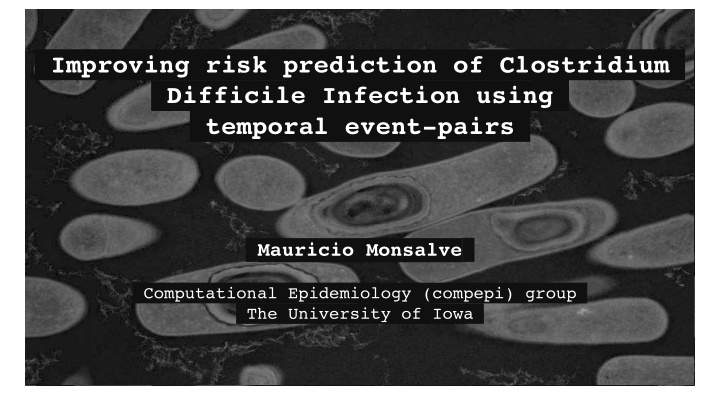



Improving risk prediction of Clostridium Difficile Infection using temporal event-pairs Mauricio Monsalve Computational Epidemiology (compepi) group The University of Iowa
A A T T A G A G LANCE LANCE • Clostridium Difficile Infection (CDI) is a contagious HAI that burdens healthcare and is becoming increasingly deadly • We improve CDI prediction using of an ensemble of logistic regression classifiers, that processes patient visits described as pairs of events (chronologically orders) • Extensive feature selection to prevent overfitting • We apply our approach to a rich dataset from the University of Iowa Hospitals and Clinics (UIHC) • We produce better risk predictions (AUC) than existing estimators and identify novel risk factors.
O O UTLINE UTLINE 1. At a glance 2. Clinical motivation 3. Data mining motivation 4. Proposed method 5. Results 6. Concluding remarks
C C LINICAL LINICAL M M OTIVATION OTIVATION • In the United States, during 2011 alone ◦ half a million patients suffered from CDI ◦ 29,000 died within 30 after diagnosis • CDI is specially troublesome because ◦ threatens the weakest patients ◦ is triggered by antibiotics of choice ◦ survives alcohol, reduced gastric acid, and dryness of environment (spores, for months) ◦ costly: extra days, expensive antibiotics
• Clinical motivation: ◦ To help in the early identification of patients at high risk of developing CDI • Why? ◦ Prepare to treat a patient for CDI ◦ Preventive isolation (minimize spread) ◦ Targeted sanitization ◦ Observe nearby patients • Early identification? ◦ Best use patient's visit history to assess risk
D D ATA ATA M M INING INING M M OTIVATION OTIVATION
◦ To estimate the risk of a patient of developing CDI by using the data on the patient's visit so far • Order of clinical events relevant to onset of CDI • To describe a patient's visit as ordered events
• Difficulties : ◦ CDI affected patients are a minority: ~2,000 v. ~200,000 ◦ CDI patients arrived diseased or left early (<1,000) ◦ Sparsity of events: a patient can only be associated to very, very few diagnoses, procedures, prescriptions ◦ Feature explosion: combinations of clinical events generate too many features (millions with just two events) ◦ Summing up: computational cost + risk of overfitting
P P ROPOSED ROPOSED M M ETHOD ETHOD • To describe visits using pairs of events • To rely on an ensemble to ◦ Counter class imbalance ◦ Split computational cost • Logistic regression model in each unit of the ensemble ◦ Remove irrelevant features, while ◦ Minimize BIC to quasi-maximize out-of-sample validity ◦ Using regularization
Chronologically ordered pairs of events • Only pairs of events? ◦ Partial orders of minimal complexity ◦ In principle , induce millions of features • (x,y) or “[x < y]” reads as ◦ Event x occurred before event y ◦ Or, both events occurred in the same day • Examples: ◦ [To=OR < To=MICU] ◦ [Proc=216 < RxMin=812] ◦ [@Diag=135 < @Age=50]
• Admission data is treated as events • Examples: ◦ @Age=20 ◦ @Severity=HIGH ◦ @Diag=135 ◦ @DiagPrev=135 • Manufactured events ◦ @pcr_period ◦ @cdi_1year ◦ Pressure=HIGH
Hierarchies • Available hierarchies: ◦ Medications, procedures, diagnoses • Hierarchies can be revealing: ◦ E.g., are particular antibiotics risk factors or the whole category of antibiotics is a risk factor? • How to consider hierarchies? ◦ Let (x,y) be a pair of events, and x:S and y:T ◦ Besides (x,y), consider also (S,y), (x,T), (S,T) • If we plan to prune features thoroughly, might as well introduce tentative features
• Individual classifiers: logistic regression • Why? ◦ Binary features—logistic regression is MaxEnt ◦ Sparsity linearizes associations ◦ Regularization possible ◦ Sparsity + L1 regularization—L1-L0 equivalence • Feature selection is cheap[er] with regularization • Fast feature selection scheme—two passes ◦ First pass: fast, inaccurate—remove low impact features ◦ Second pass: slow[er], accurate—L1 regularization
• Step 2: minimize BIC defined as BIC =− 2 L +( 1 + | β | 0 ) ln| S | , where L is defined as L (α , β ; λ)=λ | β | 1 + ∑ ( x , y )∈ S ln ( 1 + exp (− y (α+β Tx )) ) , by searching using α , β , λ • Encouraged by L0-L1 equivalence
R R ESULTS ESULTS Several experiments 1. Using only two days worth of data (comparison against state of the art: Wiens et al 2014)—85% v. 80% accuracy 2. Using more days worth of data—using pairs of events v. bare events: 86% v. 85% 3. What occurs to risk estimate as onset of CDI nears— sensitivity increases 4. Admission data v. strictly clinical events—83% v. 79% 5. Impact of BIC minimization step—+2% out-of-sample accuracy and 1,500 features removed
Experiment 1 (v. s-o-a) Experiment 2 (pairs v. bare)
Experiment 3: risk curves (sensitivity)
Experiment 4: Admission data versus clinical events only • Admission data very predictive • Required for prediction • Clinical events only limited predictive ability
C C ONCLUDING ONCLUDING R R EMARKS EMARKS • Possible to outperform literature, but admission data is very predictive ◦ Event data introduces marginal improvements ◦ Useful for risk curves—impossible with admission data • CDI Colonization Pressure deemed irrelevant by the classifier • Future work ◦ Improvement of classification methodology ▪ Better distinguish relevant features (order, hierarc.) ▪ Trade-off size of ensemble, complexity of units ◦ Further study role of transmission in CDI
Recommend
More recommend